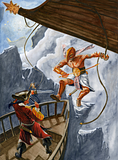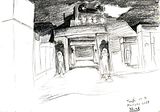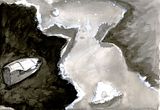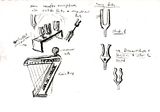Man, I really need to get used to doing the whole blogging thing. Anyway, here's the first culture I'm working on:
Khund

A picture of a Khundi Roc Cult warrior raiding a smuggler vessel.
Most people, when they think of the Khundi, shudder and imagine slavering savages, drenched in the gore of their victims. They have images of dark ships that seem to come out of nowhere, populated by the restless corpses and corpsemakers.
Most people aren't exactly wrong.
The Khundi hail from a nightworld, a continent so close to the core that its lightside is uninhabitable, but the back is barely capable of supporting life. This is primarily because of the significant volcanic activity on the surface. Water vapor is released with each eruption, which does eventually condense.
Khund's barrens are covered in a perpetual reddish twilight, only broken by its moon, Sethix, and reflected light from other continents. The landscape is mostly arid plateaus with some actual sandy expanses in between. Temperatures shift between freezing cold to boiling hot almost at random, which ultimately is a good thing; it means that there are some small open bodies of water. Dust storms are common, fueled by the crosswinds from the mountainous edges.
What life does eke out a place in the harsh environs of Khund is hardy, vicious, and utterly consumed by survival by any means necessary. From the lichens and molds that produce clouds of toxic spores to provide fertilizer for their new colonies, to the swarms of vicious Piranah Flies, all the way up to the heavily armored Gargantulon and the unsettling visage of the Manticora, Khund has produced some of the most brutal and rugged species to exist on any known continent, not the least of which is the Khundi themselves.

Concept art for a Khundi warrior
The average Khundi stands somewhere between 5 feet and 6 feet tall, and is usually heavily muscled. Biologically they seem to be derived from the same stock as Phaethusan and Daleni Humans, but they've evolved in strange ways. Their eyes are like a cat's; the retinas are mirrored. Their blood has nuclei like a bird. Their jaws are over-muscled and full of razor sharp teeth, giving them the ability to bite all the way through most creatures bones. Somehow, they use 75% less water than any other known species of sentient. Technically, the Khundi (which is both plural and singular, like "sheep") can interbreed with other human sub-species, but the offspring is an infertile hybrid like a mule.

Temple of the Manticora on Khund
Khund has exactly seven cities on it, the largest and most powerful of them is Ossusxar, the city of the Restless Dead. Each necrometropolis is serviced by its nomadic clans that only stop in every couple of years. Generally the ships bring in slave labor in the form of zombified remains, water, some food that stores well, weapons, and luxury goods. A necrometropolis is built around a central temple to one of the Khundi deities, and each temple is run by priesthood. Everyone who isn't a priest or a warrior is a slave to the other two classes' desires. Most of the really hard labor is performed by the zombies, but some of the more complicated tasks must be handled by a live Khundi. Those that aren't doing hard labor, become servants to the upper classes.
Each necrometropolis is ruled by the priesthood, which is headed by a council of necrarchs, undead mummified corpses that are nigh-immortal. To be selected for this form of preservation is the highest honor one can achieve in Khundi society; it means that your continued survival is necessary. Traditionally warriors are picked for cunning, ruthlessness, and victory in battle, while priests are picked for cunning, ruthlessness, and victory in temple politics. The aspirant then goes through a lengthy ritual of self-mummification, which culminates in being entombed alive in a sarcophagus. Only one in five aspirants successfully becomes a necrarch. Warriors then join the Sarcophagants, the protectors of their tomb city, and may be chosen as clan leaders in the raiding clans. Priests go onto the necrarch council. Necrarchs aren't entirely immortal, but they generally last for at least 3000 years baring exceptional circumstances. They can be destroyed, as long as every body part is completely destroyed, which can be tricky. The Necrarchs have a nasty habit of storing excess organs (like their lungs and heart) in hidden burial chambers in temples, and can be resurrected from a sliver of flesh or bone by a simple harmonic manipulation.
Most Khundi no longer live on their home continent; indeed, the phrase "going home" has an entirely different connotation in Khundi. The usual family unit is the clan, which resides on somewhere between one and ten skycraft, made from whatever they have available. Clan size can range from 100 members to 3000. The clan unit is typically led by a necrarch who makes all of the choices in who and what to raid. The Khundi culture is one of institutionalized piracy, since the entire world appears ripe for the taking to their ravenous eyes. Almost all of their thaumaturgy is stolen, although a few of their more memorable tricks are home grown.
The Khundi are well known for their use of necromantic techniques, most notably their method of elasticizing corpses with a rubber-like substance after completely desiccating them. This leads to a unique and bizarre appearance for their zombies, as the rubber around the joints cracks in the extreme temperatures. They also have a tendency to carve runic systems into their flesh, creating a powerful set of defenses scarified directly onto them. Likewise, runic tattoos are common amongst the warrior class.

